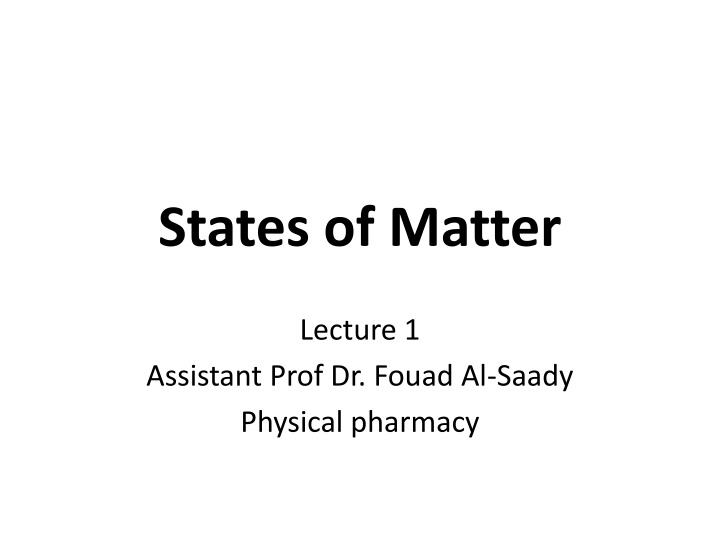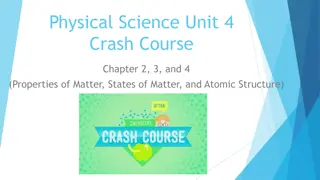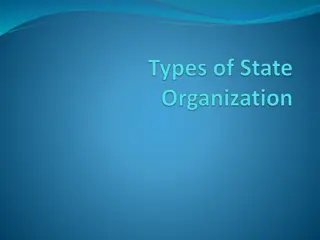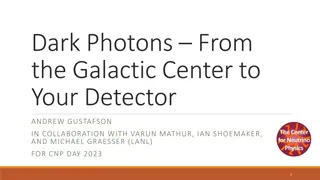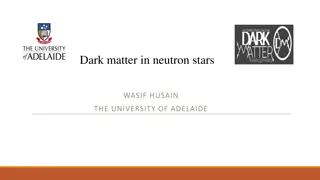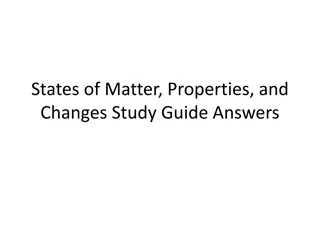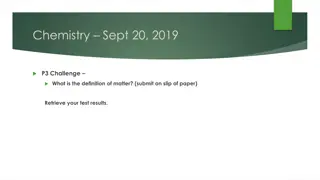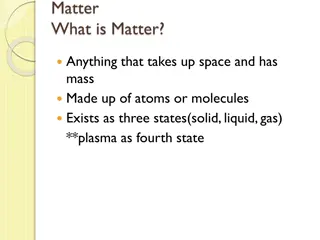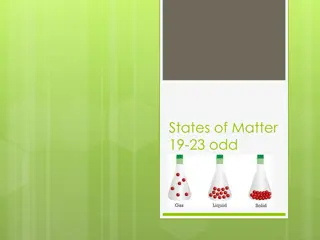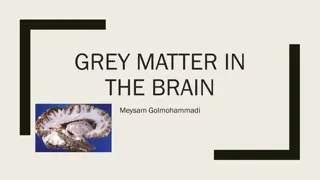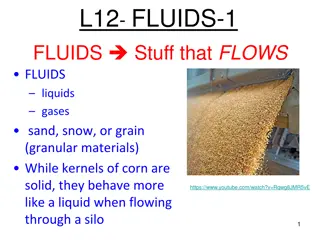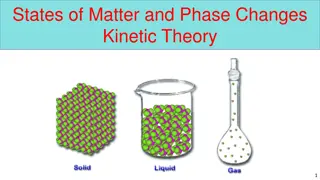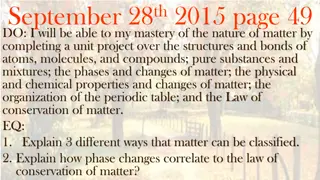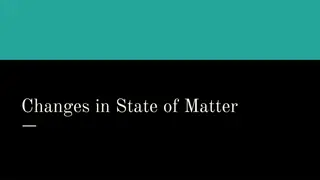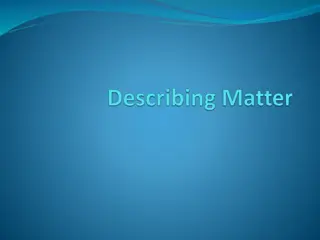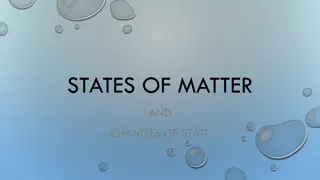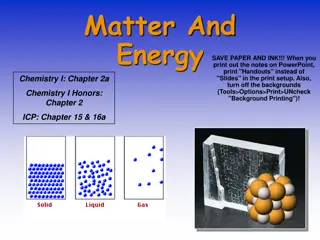States of Matter
In this lecture by Assistant Prof. Dr. Fouad Al-Saady on physical pharmacy, the focus is on understanding the intermolecular forces that govern the behavior of molecules in different states of matter. Topics covered include cohesive and adhesive forces, repulsive and attractive forces, as well as the equilibrium distance where molecules are most stable. Van der Waals forces are also discussed as weak interactions that play a role in molecular interactions.
Download Presentation

Please find below an Image/Link to download the presentation.
The content on the website is provided AS IS for your information and personal use only. It may not be sold, licensed, or shared on other websites without obtaining consent from the author.If you encounter any issues during the download, it is possible that the publisher has removed the file from their server.
You are allowed to download the files provided on this website for personal or commercial use, subject to the condition that they are used lawfully. All files are the property of their respective owners.
The content on the website is provided AS IS for your information and personal use only. It may not be sold, licensed, or shared on other websites without obtaining consent from the author.
E N D
Presentation Transcript
States of Matter Lecture 1 Assistant Prof Dr. Fouad Al-Saady Physical pharmacy
Binding Forces Between Molecules For molecules to exist as aggregates in gases, liquids, and solids, intermolecular forces must exist. Cohesion: the attraction of like molecules adhesion: the attraction of unlike molecules are manifestations of intermolecular forces Repulsion is a reaction between two molecules that forces them apart.
Intermolecular forces are forces between molecules Inter' means between, so these are the forces between molecules. Intramolecular forces act within molecules, which are the strong forces that keep a molecule together. Intra' means inside, so these are the inside forces in a molecule. Intermolecular forces are weaker than intramolecular forces.
Repulsive and Attractive Forces When molecules interact, both repulsive and attractive forces operate. As two atoms or molecules are brought closer together, the opposite charges and binding forces in the two molecules are closer together than the similar charges and forces, causing the molecules to attract one another. The negatively charged molecules largely (equilibrium) forces between the two molecules .When the molecules are brought so close that the outer charge clouds touch, they repel each other like rigid elastic bodies. electron clouds balance of govern the
Thus, attractive forces are necessary for molecules to cohere, whereas repulsive forces act to prevent the interpenetrating and annihilating each other. molecules from
Repulsion is due to the interpenetration of the electronic clouds of molecules and increases exponentially with a decrease in distance between the molecules. At a certain equilibrium distance, about (3-4)x 10 8cm (3 4 ), the repulsive and attractive forces are equal. At this position, the potential energy of the two molecules is a minimum and the system is most stable in the following figure.
Van der Waals Forces Van der waal interactions are weak forces that involve the dispersion of charge across a molecule called a dipole. A. In a permanent dipole, called keesom forces
B. Debye permanent dipole to polarize charge in a neighboring molecule. forces show the ability of a H H C H O H
C. In London forces, two neighboring neutral molecules, for example, aliphatic hydrocarbons, induce partial charge distributions. Without this polarization, the membrane interior would be destabilized and lipid bilayers might break down. Therefore, London forces give rise to the fluidity and cohesiveness of the membrane under normal physiologic conditions.
Ion-Dipole and Ion-Induced Dipole Forces: They occur between polar or non-polar molecules and ion. These types of interactions account in part for the solubility of ionic crystalline substances in water, the cation for example attracting the relatively negative oxygen atom of water and the anion attracting the hydrogen atoms of the dipolar water molecules.
Ion-induce formation of iodide complex and accounts for solubility of iodide in a solution of potassium iodide. dipole forces are involved in the
Hydrogen Bonds The interaction between a molecule containing a hydrogen atom and a strongly electronegative atom such as fluorine, oxygen, or nitrogen is of particular interest. Such a bond, exists in ice and in liquid water; it accounts for many of the unusual properties of water including its high dielectric constant, abnormally low vapor pressure, and high boiling point. The structure of ice is an open but well ordered three-dimensional array of regular tetrahedra with oxygen in the center of each tetrahedron and hydrogen atoms at the four corners.
Hydrogen bonds can also exist between alcohol molecules, carboxylic acids, aldehydes, esters, and polypeptides. The hydrogen bonds of formic acid and acetic acid are sufficiently strong to yield dimers (two molecules attached together), which can exist even in the vapor state. Hydrogen fluoride in the vapor state exists as a hydrogen-bonded polymer (F H )n, where n can have a value as large as 6. This is largely due to the high electronegativity of the fluorine atom interacting with the positively charged hydrogen atom.
It will be noticed that intra- as well as intermolecular hydrogen bonds may occur (as in salicylic acid).
States of Matter Gases , liquids and crystalline solids are the three primary states of matter . The molecules , atoms ,ions in the solid state are held in close proximity by intermolecular , interatomic or ionic forces. The atoms in the solid can oscillate only about fixed positions. As the temperature of a solid is raised, the atoms acquire sufficient energy to disrupt the ordered arrangement of lattice and pass into the liquid form.
Finally when sufficient energy is supplied , the atoms or molecules pass into the gaseous state.
The Gaseous State Owing to vigorous and rapid motion and resultant collisions ,gas molecules travel in random paths and collide not only with one another but with the walls of containers in which they are confined. Hence, they exert a pressure a force per unit area- expressed in dyne / cm2. Pressure is also recorded in atmosphere or in milliliters of mercury. Another characteristic is volume which is expressed in liters or cubic centimeters .
The temperature is measured in absolute or kelvin scale .Zero degrees of centrigrade is equal to 273.15 K. Ideal Gas Equation Refer to ideal situation where no intermolecular interaction exist and no energy is exchanged upon collision
The conditions 0 0C and 1 atm are called standard temperature and pressure (STP). Experiments show that at STP, 1 mole of an ideal gas occupies 22.414 L. PV = nRT =(1 atm)(22.414L) (1 mol)(273.15 K) R = PV nT R= 0.082057 L atm / (mol K)
Example What is volume of 2 moles of ideal gas at 25 C and 780 mmHg? ( 1 atm =760 mmHg and R = 0.08205 L atm / (mol K) P= 780/760 = 1.026 atm V= ? n=2 mole T= 25 C+273= 298 k
PV= n R T 1.026 atmx V = 2moles x0.08205 L atm x298K mole.K V= 47.65 liter
